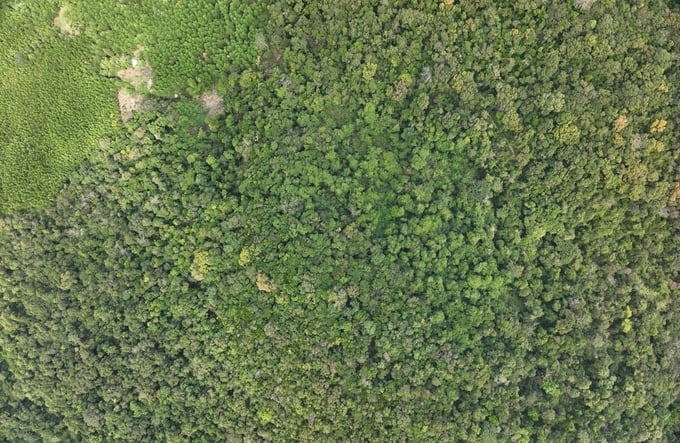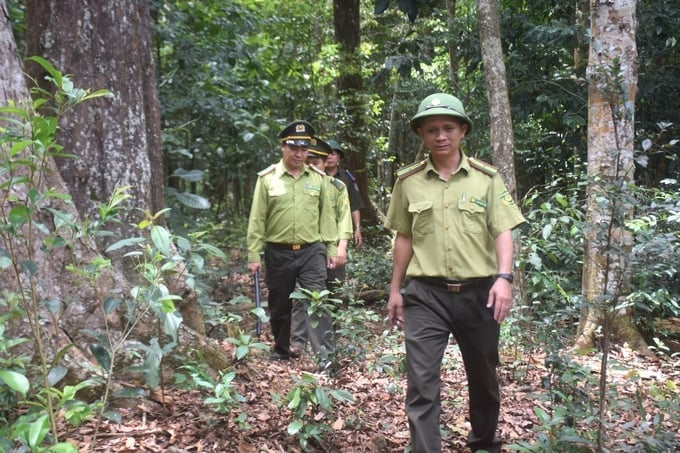June 5, 2025 | 01:32 GMT +7
June 5, 2025 | 01:32 GMT +7
Hotline: 0913.378.918
June 5, 2025 | 01:32 GMT +7
Hotline: 0913.378.918
Binh Dinh province is currently home to over 415,724 hectares of forest and forestry land, including more than 345,580 hectares of forested area. This area comprises over 214,543 hectares of natural forests and 131,036 hectares of planted forests. The remaining area consists of newly planted forests or land without forest coverage.
Forest protection forces in Binh Dinh province has promoted the application of technology in monitoring, managing, protecting, and developing forests. As a result, the province's capacity to monitor, manage protect, and prevent forest fires have vastly improved, with notable achievements in the timely detection of violations pertaining to the Law on Forestry.

Binh Dinh province's Sub-Department of Forest Protection monitors local forest conditions using aerial technology. Photo: V.D.T.
According to Le Duc Sau, General Director of Binh Dinh province's Sub-Department of Forest Protection, local forest protection forces has utilized the FRMS software, deployed by the Ministry of Agriculture and Rural Development, to update forest changes; the FireWatch Vietnam online forest fire monitoring system, deployed by the Department of Forest Protection, and the v5PFES software to delineate areas for forest environmental service payments; and various GIS software installed on computers and mobile devices such as QGIS, MapInfo, Global Mapper, Vtool, and GeoPFES.
The enhanced forest management system enabled local authorities to promptly update forest changes, monitor forest status through satellite imagery, and accurately collect data to effectively oversee forest development.
According to Tran Trong Toan, Deputy Head of Vinh Thanh district's Forest Protection Department in Binh Dinh province, the application of specialized software has facilitated local forest management and protection efforts. “Data on forest area, delineation of forest plots, compartments, and sub-compartments are digitized in an uniform manner within the system. During forest patrols, the district's forest protection force uses GPS devices or the software installed on their phones to immediately identify locations of forest fires, deforestation, and illegal encroachment on forestry land,” explained Tran Trong Toan.
Nguyen On, Head of the Tay Son district's Forest Protection Department in Binh Dinh province, added that the use of information technology in forest management and protection also allows local forest protection forces to monitor forest status at ease, thereby saving time and manpower. With software updating satellite images to monitor forest changes and issue early fire warnings, Tay Son district's Forest Protection Department has promptly deployed response forces when necessary.

Tran Trong Toan, Deputy Head of Vinh Thanh district's Forest Protection Department in Binh Dinh province, leading a forest patrol team. Photo: V.D.T.
"During the dry season when the risk of forest fires is high, the FireWatch Vietnam online forest fire monitoring software will detect and issue fire warnings. Based on data analysis and satellite imagery of potential or suspected fire sites, we can accurately approach these locations to implement timely fire prevention and firefighting solutions, thereby minimizing damage," Nguyen On shared.
With the aim of promoting digital transformation in the forest protection sector, General Director Le Duc Sau stated that Binh Dinh province's government will further enhance the application of digital technology in forest management and protection, monitor forest changes, and issue early fire risk warnings.
On the other hand, the province will focus on upgrading the local infrastructure, computer systems, and high-quality internet networks; purchase modern equipment and tools such as drones aid in forest patrol and inspection efforts.
"The Sub-Department of Forest Protection has advised Binh Dinh province's Department of Agriculture and Rural Development to propose that the Provincial People's Committee invest in training and improving the professional skills of local forest protection forces, forest owners, and stakeholders responsible for the digital transformation process," commented Le Duc Sau, General Director of Binh Dinh province's Sub-Department of Forest Protection.
As an alternative to burning, post-harvest forest vegetation in Binh Dinh province is spread onto new planting beds to create humus and enhance the soil's health for the next forest planting season.
Binh Dinh province currently houses over 130,000 hectares of planted forests, with approximately 10,000 hectares harvested and replanted each year. Post-harvest forest vegetation was previously cleared and burned to make space for new planting holes. During heatwaves, vegetation burning posed a high risk of forest fires. Additionally, the smoke and dust from vegetation burning activities caused significant air pollution.
Translated by Nguyen Hai Long

(VAN) Technology is redrawing the map of Vietnamese aquaculture: more modern, greener, and more sustainable.

(VAN) Novel process harnesses machine learning to reveal groups of genes that determine how efficiently plants use nitrogen.

(VAN) Several scientists and farmers are experimenting with soil treatment in some key durian-growing regions such as Cai Lay (Tien Giang), Dak Song, Gia Nghia, and Dak R’lap (Dak Nong).
/2025/05/25/4127-3-073637_820.jpg)
(VAN) Thanks to the promotion from an FAO-implemented project, vegetable production in greenhouses in Moc Chau has seen strong development, from 1.5 hectares in 2021 to nearly 50 hectares in 2024.

(VAN) FAO has recently supported USD 140,000 to implement the project 'Risk mitigation human-animal interface risks through disease control initiatives in pig farming.'

(VAN) The People's Committee of Tra Vinh province has approved an adjustment to the investment policy for the Green Hydrogen Plant project, increasing its area to approximately 52.76 hectares.
![Reducing emissions from rice fields: [2] Farmers’ commitment to the soil](https://t.ex-cdn.com/nongnghiepmoitruong.vn/608w/files/news/2025/05/05/dsc08881jpg-nongnghiep-140632.jpg)
(VAN) Clean rice cultivation model in Thuong Tan commune, Bac Tan Uyen district, is assisting local residents in achieving sustainable agriculture by substantially reducing costs, increasing productivity, and protecting the environment.